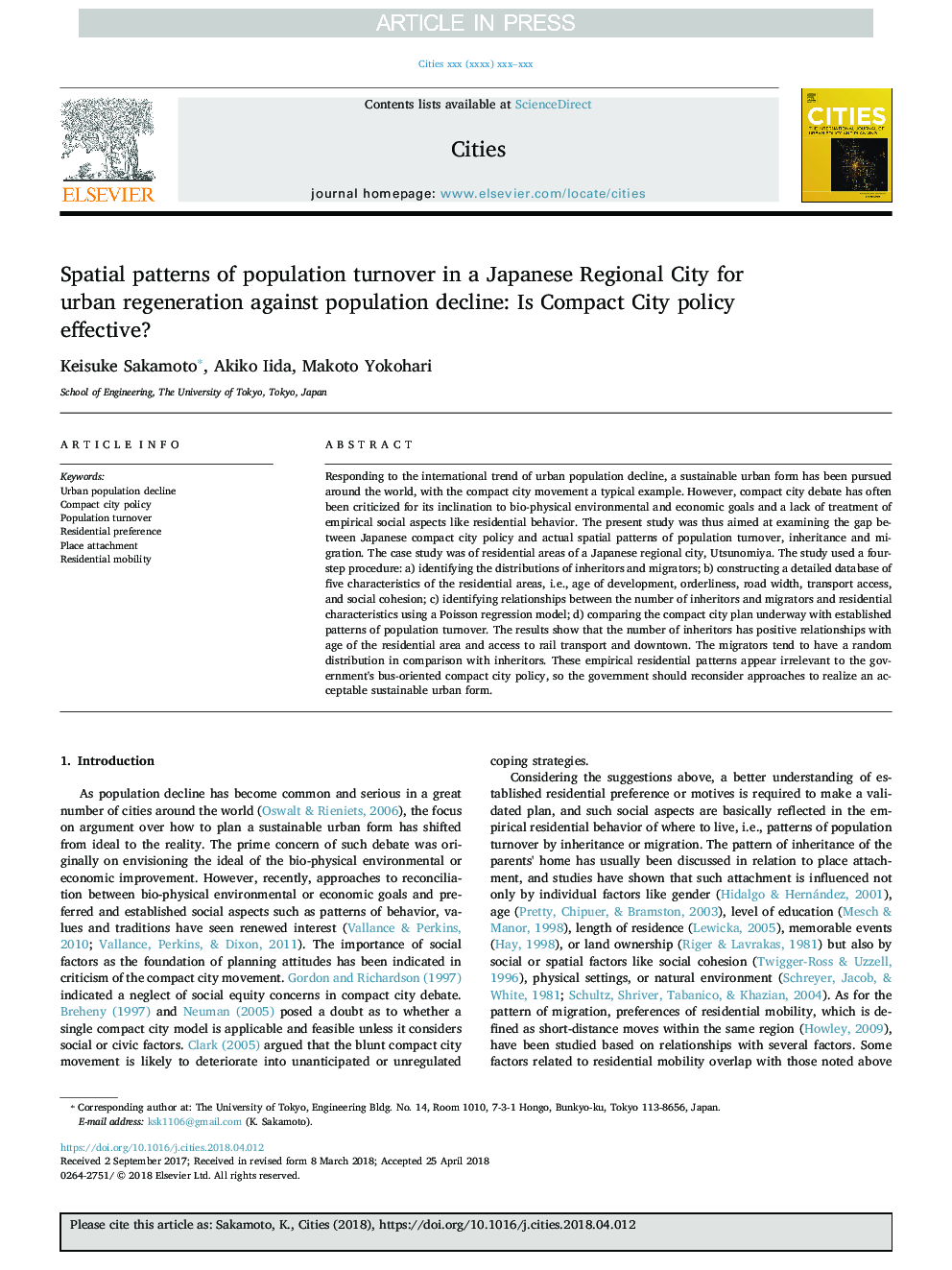| کد مقاله | کد نشریه | سال انتشار | مقاله انگلیسی | نسخه تمام متن |
|---|---|---|---|---|
| 8954671 | 1646031 | 2018 | 12 صفحه PDF | دانلود رایگان |
عنوان انگلیسی مقاله ISI
Spatial patterns of population turnover in a Japanese Regional City for urban regeneration against population decline: Is Compact City policy effective?
ترجمه فارسی عنوان
الگوهای فضایی گردش درآمد در یک شهر منطقه ای ژاپن برای بازسازی شهری در برابر کاهش جمعیت: آیا سیاست شهر کمکی موثر است؟
دانلود مقاله + سفارش ترجمه
دانلود مقاله ISI انگلیسی
رایگان برای ایرانیان
کلمات کلیدی
کاهش جمعیت شهری، سیاست شهرکشی، گردش مالی جمعیت، ترجیح مسکونی، پیوست محل تحرک مسکونی،
ترجمه چکیده
با توجه به روند جهانی کاهش جمعیت شهری، یک شکل شهری پایدار در سراسر جهان مورد توجه قرار گرفته است. با این حال، بحث های جمع و جور شهر اغلب به خاطر اهتمام به اهداف زیست محیطی و اقتصادی اقتصادی و عدم توجه به جنبه های اجتماعی تجربی مانند رفتار مسکونی انتقاد شده است. بنابراین مطالعه حاضر با هدف بررسی شکاف بین سیاست شهری جمعی ژاپن و الگوی فضایی واقعی جابجایی جمعیت، ارث و مهاجرت انجام شده است. مطالعه موردی مناطق مسکونی یک شهر منطقه ای ژاپن، اوتسونومیا بود. این مطالعه از یک روش چهار مرحله ای استفاده کرد: الف) شناسایی توزیع وارثان و مهاجرین؛ ب) ساخت یک پایگاه اطلاعاتی دقیق از پنج ویژگی مناطق مسکونی، یعنی سن توسعه، نظم، عرض جاده، دسترسی به حمل و نقل و انسجام اجتماعی؛ ج) شناسایی روابط بین تعداد میراث و مهاجرین و ویژگی های مسکونی با استفاده از مدل رگرسیون پواسون؛ د) مقایسه نقشه شهر فشرده که در حال انجام است با الگوهای ثابت گردش مالی جمعیت. نتایج نشان می دهد که تعداد وارثان رابطه ای مثبت با سن مسکونی و دسترسی به حمل و نقل ریلی و مرکز شهر دارد. مهاجران تمایل دارند توزیع تصادفی در مقایسه با وارثان داشته باشند. این الگوهای مسکونی تجربی به نظر نمی رسد در سیاست شهرک سازی شهرک های اتوبوسرانی دولت، به این ترتیب دولت باید رویکردی برای تحقق یک شکل قابل قبول شهری پایدار را تجدید نظر کند.
موضوعات مرتبط
علوم انسانی و اجتماعی
مدیریت، کسب و کار و حسابداری
گردشگری، اوقات فراغت و مدیریت هتلداری
چکیده انگلیسی
Responding to the international trend of urban population decline, a sustainable urban form has been pursued around the world, with the compact city movement a typical example. However, compact city debate has often been criticized for its inclination to bio-physical environmental and economic goals and a lack of treatment of empirical social aspects like residential behavior. The present study was thus aimed at examining the gap between Japanese compact city policy and actual spatial patterns of population turnover, inheritance and migration. The case study was of residential areas of a Japanese regional city, Utsunomiya. The study used a four-step procedure: a) identifying the distributions of inheritors and migrators; b) constructing a detailed database of five characteristics of the residential areas, i.e., age of development, orderliness, road width, transport access, and social cohesion; c) identifying relationships between the number of inheritors and migrators and residential characteristics using a Poisson regression model; d) comparing the compact city plan underway with established patterns of population turnover. The results show that the number of inheritors has positive relationships with age of the residential area and access to rail transport and downtown. The migrators tend to have a random distribution in comparison with inheritors. These empirical residential patterns appear irrelevant to the government's bus-oriented compact city policy, so the government should reconsider approaches to realize an acceptable sustainable urban form.
ناشر
Database: Elsevier - ScienceDirect (ساینس دایرکت)
Journal: Cities - Volume 81, November 2018, Pages 230-241
Journal: Cities - Volume 81, November 2018, Pages 230-241
نویسندگان
Keisuke Sakamoto, Akiko Iida, Makoto Yokohari,
